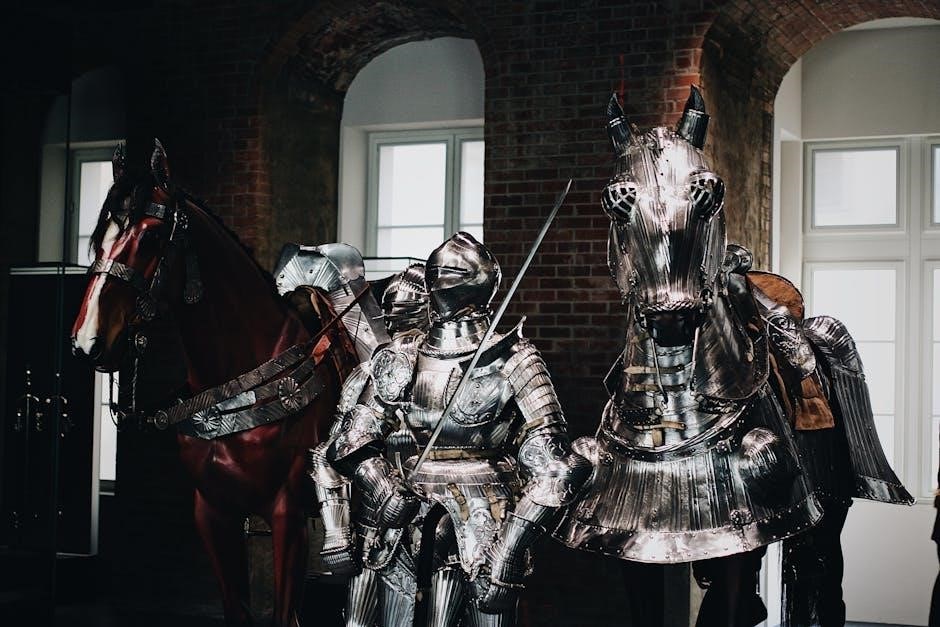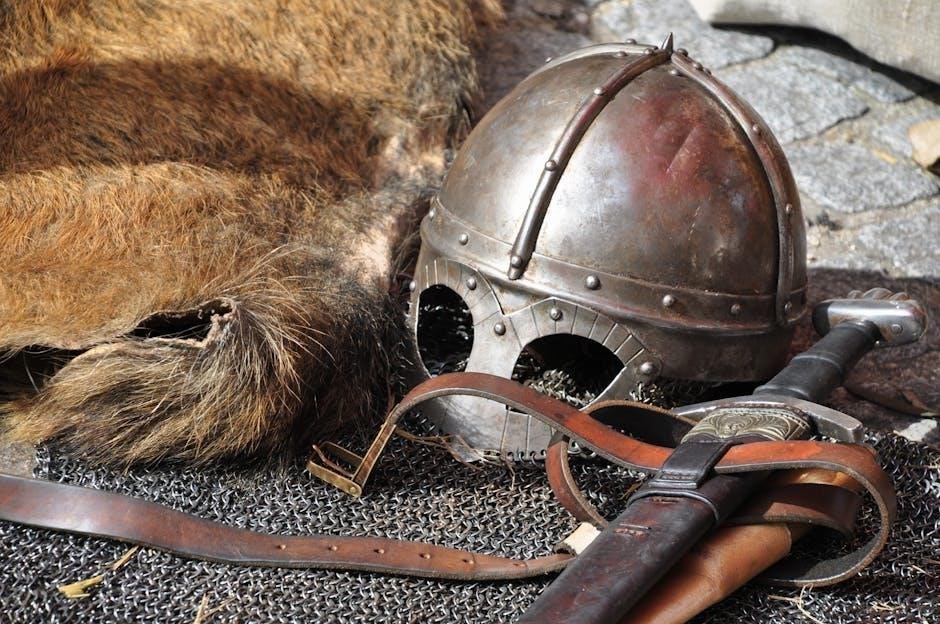John Taylor Gatto’s Weapons of Mass Instruction critiques traditional education‚ arguing it stifles creativity and discourages critical thinking‚ while promoting rote memorization and conformity‚ sparking debates on educational reform․
Overview of “Weapons of Mass Instruction PDF”
Weapons of Mass Instruction PDF by John Taylor Gatto is a compelling critique of traditional education systems․ Drawing from his 30-year teaching career‚ Gatto argues that compulsory schooling undermines creativity‚ discourages critical thinking‚ and fosters a workforce focused on obedience rather than innovation․ The book explores the historical roots of modern education‚ linking it to the Prussian model designed to produce compliant citizens․ Gatto’s passionate analysis challenges readers to rethink the purpose and structure of schooling‚ offering insights into the societal impact of standardized education․ The PDF version is widely accessible‚ making Gatto’s provocative ideas available to a broad audience․
Importance of the Topic in Modern Education
John Taylor Gatto’s Weapons of Mass Instruction is a critical examination of modern education‚ highlighting its role in suppressing creativity and fostering conformity․ The book challenges the notion that traditional schooling prepares students for success‚ instead arguing that it creates a docile workforce․ Gatto’s critique resonates amid growing concerns about standardized education and its impact on individual potential․ His ideas have sparked debates about educational reform‚ making the topic increasingly relevant for educators‚ policymakers‚ and parents seeking alternative approaches to learning․ The PDF’s accessibility ensures Gatto’s message reaches a wide audience‚ inspiring reflection on the future of education․

Author Background
John Taylor Gatto‚ a former New York State Teacher of the Year‚ spent three decades in education‚ becoming a prominent critic of compulsory schooling and advocating for reform․
John Taylor Gatto: A Brief Biography
John Taylor Gatto‚ a renowned American author and educator‚ spent over 30 years teaching in New York public schools․ He became a vocal critic of compulsory schooling‚ advocating for educational reform․ Gatto’s experiences led him to write Weapons of Mass Instruction‚ where he critiques traditional education systems․ His work challenges the notion of schooling as a tool for creativity suppression and conformity․ Gatto’s insights have significantly influenced homeschooling movements and alternative education‚ making him a key figure in modern educational discourse․
Gatto’s Contributions to Educational Criticism
John Taylor Gatto is a prominent critic of traditional education‚ arguing that compulsory schooling suppresses creativity and critical thinking․ His work challenges the notion that education should prioritize conformity over individuality․ Gatto’s critiques highlight how rote memorization and standardized systems fail to foster meaningful learning․ By advocating for educational reform‚ he has inspired movements toward homeschooling and alternative learning models․ His ideas have sparked significant debate‚ making him a pivotal figure in modern educational criticism and reform efforts․
Other Notable Works by John Taylor Gatto
John Taylor Gatto is renowned for his critical perspectives on education․ His book Dumbing Us Down introduced the concept of how traditional schooling undermines intellectual growth․ Another significant work‚ The Underground History of American Education‚ explores the historical roots of compulsory schooling and its societal impact․ These works‚ alongside Weapons of Mass Instruction‚ have solidified Gatto’s reputation as a leading voice in educational criticism‚ inspiring reform and alternative learning movements worldwide․
Main Themes of the Book
Weapons of Mass Instruction critiques traditional education for stifling creativity‚ discouraging critical thinking‚ and promoting rote memorization․ It explores the historical roots of compulsory schooling and its societal impact․
Critique of Traditional Education Systems

John Taylor Gatto’s Weapons of Mass Instruction delivers a scathing critique of traditional education‚ arguing that it stifles creativity‚ discourages critical thinking‚ and prioritizes rote memorization over meaningful learning․ Gatto contends that the system‚ modeled after the Prussian education model‚ was designed to produce compliant‚ factory-ready workers rather than independent thinkers․ He highlights how this approach suppresses individual potential‚ fostering a culture of conformity and passive acceptance․ By examining the historical and societal roots of compulsory schooling‚ Gatto challenges readers to rethink the purpose and impact of modern education․
The Role of Rote Memorization in Learning
John Taylor Gatto’s Weapons of Mass Instruction emphasizes the detrimental role of rote memorization in traditional education‚ arguing that it stifles creativity and discourages critical thinking․ Gatto asserts that this method creates a false narrative that learning is merely about memorizing facts rather than understanding concepts or fostering innovation․ By prioritizing rote learning‚ the education system often neglects the development of independent thought‚ leaving students ill-equipped to engage with complex ideas or solve real-world problems creatively․

Effects of Compulsory Schooling on Creativity
John Taylor Gatto’s Weapons of Mass Instruction argues that compulsory schooling stifles creativity by imposing rigid structures and standardization․ He contends that the system discourages independent thought and imagination‚ fostering conformity instead of innovation․ By prioritizing rote memorization and obedience‚ schools often suppress students’ natural curiosity and creative potential‚ producing a workforce more suited for industrial efficiency than intellectual exploration․ Gatto believes this undermines the development of critical thinking and original ideas‚ leaving students ill-prepared to navigate a rapidly changing world․
Historical Development of Modern Education
John Taylor Gatto traces the origins of modern education to the Prussian model‚ designed to produce obedient citizens and factory workers․ He argues that this system‚ adopted in the U․S․‚ emphasized conformity and standardization over individuality․ The Industrial Revolution further solidified this approach‚ shaping schools into institutions that prioritized efficiency and compliance․ Gatto contends that this historical trajectory has led to a system that suppresses creativity and critical thinking‚ perpetuating a cycle of passive learning and societal control․
Societal Impact of Traditional Educational Practices

Traditional education‚ as critiqued in Weapons of Mass Instruction‚ has far-reaching societal impacts․ It fosters a population conditioned to conformity‚ discouraging creativity and independent thought․ By prioritizing rote memorization and standardization‚ schools produce individuals who are less inclined to challenge authority or innovate․ This systemic approach perpetuates a workforce that values compliance over critical thinking‚ stifling societal progress and creativity․ Gatto argues that such practices contribute to a culture of passive acceptance‚ undermining the potential for meaningful change and intellectual growth across generations․

Historical Context
The Prussian education model‚ adopted in the U․S․‚ aimed to create a compliant workforce‚ suppressing creativity and critical thinking‚ shaping modern schooling’s industrialized structure․
Origins of the Prussian Education Model
The Prussian education system emerged in the 18th and 19th centuries‚ designed to produce obedient citizens and a skilled workforce․ It emphasized standardized curriculum‚ rigid discipline‚ and rote learning‚ suppressing individuality․ This model was later adopted in the U․S․‚ shaping modern compulsory schooling․ Gatto critiques this system for prioritizing conformity over creativity‚ arguing it laid the groundwork for an industrialized education focused on producing compliant workers rather than independent thinkers․
Evolution of Compulsory Schooling in the U․S․
Compulsory schooling in the U․S․ evolved in the 19th century‚ influenced by the Prussian model‚ aiming to create a uniform‚ obedient workforce for industrialization․ Laws mandated attendance‚ standardizing education and suppressing diversity․ Gatto argues this system was designed to produce compliant citizens rather than thinkers‚ fostering a culture of rote learning and conformity․ The industrial revolution further solidified this model‚ shaping schools into factories for producing a docile‚ easily manageable population‚ stifling creativity and individuality in the process․
Industrial Revolution’s Influence on Education
The Industrial Revolution reshaped education to meet the demands of a factory-based economy․ Schools adopted rigid structures‚ emphasizing discipline‚ uniformity‚ and rote learning to prepare students for industrial jobs․ Gatto argues this shift transformed education into a system that prioritized compliance over creativity‚ producing workers suited for repetitive tasks․ The Prussian model‚ adopted in the U․S․‚ further entrenched these practices‚ creating a standardized‚ factory-like schooling environment that stifled individuality and critical thinking‚ aligning with the needs of industrial capitalism rather than fostering intellectual freedom․

Impact of Compulsory Schooling
Compulsory schooling fosters a docile workforce by suppressing creativity and critical thinking‚ promoting conformity and standardization‚ which Gatto argues undermines individual potential and societal progress․
Creation of a Docile Workforce
Gatto argues that compulsory schooling systems‚ modeled after the Prussian education system‚ were designed to produce obedient and compliant individuals suited for industrial labor․
By emphasizing rote memorization and standardization‚ traditional education discourages creativity and independent thought‚ fostering a workforce that prioritizes conformity over innovation and critical inquiry․
Suppression of Critical Thinking
Gatto contends that traditional education systems systematically suppress critical thinking by prioritizing rote memorization and standardized testing over creative problem-solving and independent inquiry․
By conditioning students to rely on authority and predefined answers‚ schools discourage questioning and exploration‚ fostering a mindset that values compliance over innovation and intellectual curiosity․
This suppression‚ Gatto argues‚ results in individuals who are less equipped to challenge societal norms or think independently‚ perpetuating a cycle of conformity and limiting personal and societal progress․
Standardization of Education
Gatto argues that standardized education creates a uniform learning experience‚ stifling individuality and creativity․ By enforcing identical curricula and testing‚ schools produce students who conform to predetermined expectations rather than fostering unique thinkers․
This homogenization‚ Gatto claims‚ serves to maintain social order and prepare students for industrial roles‚ rather than encouraging intellectual exploration or personal growth‚ ultimately limiting societal progress and innovation․

Contrasting Educational Philosophies
Gatto contrasts traditional education’s focus on conformity with progressive models that emphasize creativity and critical thinking‚ advocating for a shift toward student-centered‚ adaptive learning experiences․
Progressive Education vs․ Traditional Models
Gatto argues that traditional education prioritizes conformity and rote memorization‚ stifling creativity‚ while progressive models emphasize critical thinking and individualized learning․ He advocates for a shift from rigid‚ factory-like schooling to student-centered approaches that foster innovation and personal growth․ This contrast highlights the tension between outdated systems and modern educational needs‚ urging a reevaluation of how we teach and learn․ Gatto’s critique challenges educators to embrace more dynamic and inclusive methods‚ sparking debate about the future of education․
Gatto’s Ideas vs․ Modern Educational Reforms
Gatto’s critique of traditional education contrasts sharply with modern reforms emphasizing standardized testing and technology integration․ While he advocates for dismantling rigid systems‚ contemporary reforms often aim to improve existing structures․ Gatto’s vision of learner-centered education aligns with progressive ideals but clashes with the practical challenges of scaling such models․ His ideas inspire debate‚ pushing educators to rethink priorities‚ though they don’t fully align with current policy directions․ This tension highlights the complexity of balancing innovation with systemic constraints in modern education․
Comparison with Other Critics of Education
John Taylor Gatto’s critique of education aligns with other notable critics like Ivan Illich and Paulo Freire‚ who also challenged traditional schooling․ While Illich focused on deschooling society and Freire emphasized critical pedagogy‚ Gatto uniquely highlights the historical roots of compulsory schooling and its role in suppressing creativity․ His arguments resonate with contemporary critics but stand out for their historical depth and emphasis on individual freedom․ This places Gatto among influential voices advocating for radical educational transformation‚ though his solutions often differ from progressive reformers․
The PDF Version and Its Accessibility
The Weapons of Mass Instruction PDF is widely available for free‚ offering easy access to Gatto’s critique of traditional education․ Its digital format enhances readability and sharing․
Popularity of the PDF Format
The PDF version of Weapons of Mass Instruction has gained significant popularity due to its widespread availability and ease of access․ As a free downloadable resource‚ it has reached a global audience‚ particularly appealing to homeschooling parents and educators critical of traditional schooling․ The digital format allows for easy sharing and reading on various devices‚ making Gatto’s critique of compulsory education more accessible than ever․ Its popularity underscores the growing interest in alternative educational perspectives and the convenience of digital literature in modern times․
Where to Access the PDF
The PDF version of Weapons of Mass Instruction is widely available online‚ accessible through platforms like Google Play Books‚ Perlego‚ and ResearchGate․ It can also be downloaded for free from various educational websites and repositories․ Additionally‚ many homeschooling communities and alternative education forums share links to the PDF‚ making it easily attainable for those interested in Gatto’s critique of traditional schooling․ Its accessibility has contributed to its popularity among educators and parents seeking alternative perspectives on education․
Advantages of the Digital Version
The digital version of Weapons of Mass Instruction offers unparalleled accessibility and convenience․ Readers can easily download the PDF from platforms like Google Play Books‚ Perlego‚ or ResearchGate‚ ensuring instant access to Gatto’s insights․ The digital format allows for keyword searches‚ highlighting‚ and note-taking‚ enhancing the reading experience․ Additionally‚ it eliminates the need for physical storage‚ making it environmentally friendly․ The PDF is also often free‚ reducing barriers to entry and enabling widespread dissemination of Gatto’s critical perspectives on education․

Book Reviews and Reception
Weapons of Mass Instruction has received acclaim for its bold critique of traditional education‚ with many praising its thought-provoking analysis․ Critics highlight its empowering message‚ while some argue its conclusions can be extreme‚ sparking debates on educational reform and societal impact․
Reviews of Weapons of Mass Instruction highlight its provocative critique of traditional education‚ with many praising its empowering message and thought-provoking analysis․ Critics argue that while Gatto’s ideas are compelling‚ some conclusions may be extreme․ The book has resonated strongly with homeschooling communities and educators seeking reform․ It is often contrasted with other works‚ such as Bell Hooks’ Teaching to Transgress‚ for its unique perspective on education’s role in society․ The PDF version’s accessibility has further amplified its reach and impact․
Academic Reception and Criticism
Academics praise Weapons of Mass Instruction for its bold critique of traditional education‚ but some argue Gatto’s conclusions are overly extreme․ Scholars appreciate his historical analysis of compulsory schooling and its industrial roots‚ yet critics note his views may not account for diverse educational experiences‚ particularly in underserved communities․ While Gatto’s arguments resonate with reform advocates‚ others caution against generalizing public education as a monolithic system․ The book’s impact lies in sparking dialogue‚ even as debates persist about its practical implications for modern educational systems․
Public Perception and Popularity
Weapons of Mass Instruction has gained significant attention for its provocative critique of compulsory schooling․ Many readers‚ particularly homeschooling families‚ praise its challenging perspective on traditional education․ The book’s popularity stems from its ability to spark critical thinking about learning systems․ While some critics find Gatto’s views extreme‚ the PDF’s accessibility has broadened its reach‚ making it a widely discussed and debated work in educational circles and beyond․
Influence on Homeschooling and Alternative Education
Gatto’s critique of traditional schooling resonates deeply with homeschooling families‚ inspiring many to seek alternative educational paths and reject conventional systems they believe stifle creativity and freedom․
Gatto’s Impact on Homeschooling Movements
John Taylor Gatto’s Weapons of Mass Instruction has profoundly influenced homeschooling movements by challenging traditional schooling’s limitations․ His critique of compulsory education resonates with families seeking alternatives‚ inspiring them to reject rigid systems that stifle creativity․ Gatto’s arguments about the suppression of critical thinking and imagination align with homeschooling philosophies that prioritize individualized learning and autonomy․ His work has empowered parents to question conventional education‚ fostering a growing movement toward self-directed and creative learning environments․ This shift reflects a broader desire for educational freedom and innovation․
Alternative Education Models Inspired by Gatto
John Taylor Gatto’s critique of traditional education has inspired alternative models that prioritize creativity and critical thinking․ His ideas have influenced movements like unschooling‚ which emphasizes self-directed learning‚ and project-based education‚ focusing on real-world applications․ Gatto’s vision of education as a tool for empowerment has also led to the development of community-based learning initiatives and decentralized educational networks․ These models aim to break free from the constraints of compulsory schooling‚ fostering innovation and individuality in learners․
Practical Applications of Gatto’s Ideas
Gatto’s critique of traditional education has led to practical applications in homeschooling and self-directed learning․ His ideas encourage parents and educators to adopt project-based learning‚ focusing on real-world applications rather than rote memorization․ Many have implemented decentralized learning models‚ emphasizing creativity and critical thinking․ Gatto’s vision has also inspired community-based education initiatives‚ where learning occurs through collaboration and hands-on experiences․ These approaches aim to empower individuals‚ fostering a deeper understanding of knowledge and its practical uses in society․
Critique and Counterarguments
Some critics argue Gatto’s ideas are overly radical‚ dismissing the potential of systemic improvements in education․ Others highlight the lack of practical solutions in his critique․
Counterpoints to Gatto’s Arguments
Some critics argue that Gatto’s views on education are overly radical‚ often dismissing the potential for incremental improvements within existing systems․ Others point out that his observations about urban schools are misapplied by suburban parents‚ ignoring the systemic inequalities he highlights․ Additionally‚ critics contend that Gatto’s ideas lack practical solutions‚ offering little guidance for educators seeking to reform traditional schooling․ These counterpoints highlight the tension between Gatto’s call for radical change and the need for actionable strategies within the current educational framework․
Limitations of Gatto’s Approach
Gatto’s critique of traditional education‚ while compelling‚ often lacks concrete solutions‚ leaving readers with a bleak outlook but few actionable steps․ His radical approach can alienate educators seeking incremental reforms․ Additionally‚ his focus on urban schooling challenges may not resonate with suburban or rural contexts‚ limiting the universality of his arguments․ Some critics also argue that his rejection of all institutional education dismisses the potential for positive change within existing systems‚ making his vision less practical for widespread implementation․
Responses from the Educational Community
Gatto’s critique has sparked mixed reactions‚ with some educators praising his bold challenge to traditional systems‚ while others argue his views are overly radical․ Critics contend his rejection of institutional education overlooks potential reforms within existing structures․ Supporters‚ particularly in homeschooling communities‚ appreciate his advocacy for learner autonomy․ However‚ some academics caution that his generalized critique of public education fails to account for variability in quality and innovation across different schools and regions‚ limiting the applicability of his arguments to all educational contexts․

Broader Implications and Future Directions
Gatto’s work inspires calls for radical educational reforms‚ emphasizing creativity and critical thinking over rote learning‚ potentially reshaping how societies approach schooling and personal development․
Potential for Educational Policy Changes
Weapons of Mass Instruction challenges policymakers to rethink compulsory schooling and standardized education․ Gatto’s critique highlights the need for reforms that prioritize creativity and critical thinking over rote memorization․ His arguments resonate with homeschooling and alternative education movements‚ inspiring calls for decentralized‚ individualized learning systems․ The book’s digital accessibility ensures its ideas reach a broader audience‚ potentially influencing future educational policies that emphasize innovation and autonomy in learning․
The Role of “Weapons of Mass Instruction” in Educational Reform
John Taylor Gatto’s Weapons of Mass Instruction plays a pivotal role in educational reform by challenging traditional schooling’s flaws․ The book’s critique of rote memorization and creativity suppression has sparked widespread debate‚ inspiring movements toward alternative education․ Its digital availability in PDF format ensures accessibility‚ making it a key resource for reform advocates․ Gatto’s work advocates for a shift toward personalized‚ creative learning‚ influencing policymakers and educators to rethink conventional systems and embrace innovation in education․
Future of Education Based on Gatto’s Vision
John Taylor Gatto envisions an education system that fosters creativity‚ critical thinking‚ and self-directed learning․ He advocates for moving away from standardized‚ factory-like schooling to personalized‚ empowering experiences․ Gatto’s ideas inspire a future where education is decentralized‚ with learners pursuing passions and interests freely․ Technology‚ like the Weapons of Mass Instruction PDF‚ plays a role in spreading these ideals‚ enabling widespread access to alternative educational philosophies and sparking reform․ This vision aims to cultivate independent thinkers‚ breaking free from traditional constraints and fostering a more enlightened society․
Weapons of Mass Instruction challenges traditional education’s impact on creativity and critical thinking‚ urging reform to foster independent learners and a more enlightened society․
John Taylor Gatto’s Weapons of Mass Instruction critiques traditional education for stifling creativity‚ discouraging critical thinking‚ and promoting rote memorization․ He argues that compulsory schooling‚ rooted in the Prussian model‚ was designed to produce compliant workers rather than independent thinkers․ Gatto challenges the notion that education is neutral‚ highlighting its role in shaping society and suppressing individual potential․ His work calls for radical reform‚ advocating for a system that fosters innovation and genuine learning․ The book remains a powerful critique of modern education‚ inspiring debates on its purpose and impact․
Final Thoughts on the Book’s Significance
Weapons of Mass Instruction remains a pivotal critique of modern education‚ challenging readers to rethink schooling’s purpose and impact․ Gatto’s arguments about the suppression of creativity and the promotion of conformity resonate deeply‚ inspiring movements toward alternative education․ His work not only exposes the historical roots of compulsory schooling but also advocates for a system that nurtures independent thought and innovation․ The book’s relevance endures‚ making it a cornerstone for those seeking to transform education and empower future generations․
